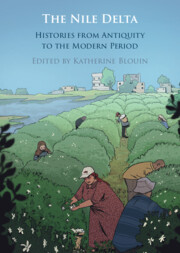Book contents
- The Nile Delta
- The Nile Delta
- Copyright page
- For Mona Abaza
- Contents
- Figures
- Maps
- Tables
- Contributors
- Acknowledgements
- Abbreviations
- 1 Introduction
- 2 Call Me by My Names
- 3 The Nile Delta before the Pharaohs
- 4 The Khetem-Border-Posts in the Delta during the New Kingdom
- 5 New Land amongst New Rivers?
- 6 The Mareotis Area
- 7 From Memphis to Alexandria
- 8 Growing with the Empire? From Village to Town
- 9 Mapping the Cult of Christian Saints in the Nile Delta from the Fifth to the Ninth Century CE
- 10 Alexandria
- 11 Imperial Power, Tribal Settlement and Fiscal Revolts in the Early Islamic Delta (Seventh to Ninth Century CE)
- 12 The Nile as Nexus
- 13 Water and Prices
- 14 Water Development in the Medieval Western Delta
- 15 The Nile Delta in European Cartography, 1200–1800
- 16 Just Passing Through?
- 17 Reclaiming the Archive
- 18 Short Commentary on Accounting Documents from a Vanishing Cotton Estate (ʿIzba) in the Nile Delta
- Index
- References
2 - Call Me by My Names
Naming the Delta through Time and Space*
Published online by Cambridge University Press: 15 February 2024
- The Nile Delta
- The Nile Delta
- Copyright page
- For Mona Abaza
- Contents
- Figures
- Maps
- Tables
- Contributors
- Acknowledgements
- Abbreviations
- 1 Introduction
- 2 Call Me by My Names
- 3 The Nile Delta before the Pharaohs
- 4 The Khetem-Border-Posts in the Delta during the New Kingdom
- 5 New Land amongst New Rivers?
- 6 The Mareotis Area
- 7 From Memphis to Alexandria
- 8 Growing with the Empire? From Village to Town
- 9 Mapping the Cult of Christian Saints in the Nile Delta from the Fifth to the Ninth Century CE
- 10 Alexandria
- 11 Imperial Power, Tribal Settlement and Fiscal Revolts in the Early Islamic Delta (Seventh to Ninth Century CE)
- 12 The Nile as Nexus
- 13 Water and Prices
- 14 Water Development in the Medieval Western Delta
- 15 The Nile Delta in European Cartography, 1200–1800
- 16 Just Passing Through?
- 17 Reclaiming the Archive
- 18 Short Commentary on Accounting Documents from a Vanishing Cotton Estate (ʿIzba) in the Nile Delta
- Index
- References
Summary
The ancient-to-modern Nile Delta has been consistently conceptualised as a coherent, distinctive region, and toponymy is one of the manifestations of this space-making process. In that regard, available evidence, which ranges from the Old Kingdom to modern times and covers a variety of scripts and languages, testifies to two partly overlapping yet simultaneously distinctive takes on the region. One adopts an insider’s, fluvial and south–north vantage point; the other, an outsider’s, maritime and north–south one. The etymology, diachronic endurance and translation of the toponyms (t3-)mḥw and Δέλτα indicate a tension between the unswerving appeal of the indigenous understanding of the Delta as a place and the long-lasting, far-reaching posterity of the ancient Greek tradition beyond and within Egypt. This chapter analyses available literary and documentary evidence of the name(s) given to what we now commonly call the Nile Delta, from Antiquity to the modern period. I propose that we consider these place names as both manifestations and vectors of stories, and reflect on their contribution to our understanding of human pluri-millennial entanglements with this territory. I first discuss the two, Egyptian and Greek, names associated with the region, before focusing on the polysignificance of the apex region.
- Type
- Chapter
- Information
- The Nile DeltaHistories from Antiquity to the Modern Period, pp. 68 - 104Publisher: Cambridge University PressPrint publication year: 2024



